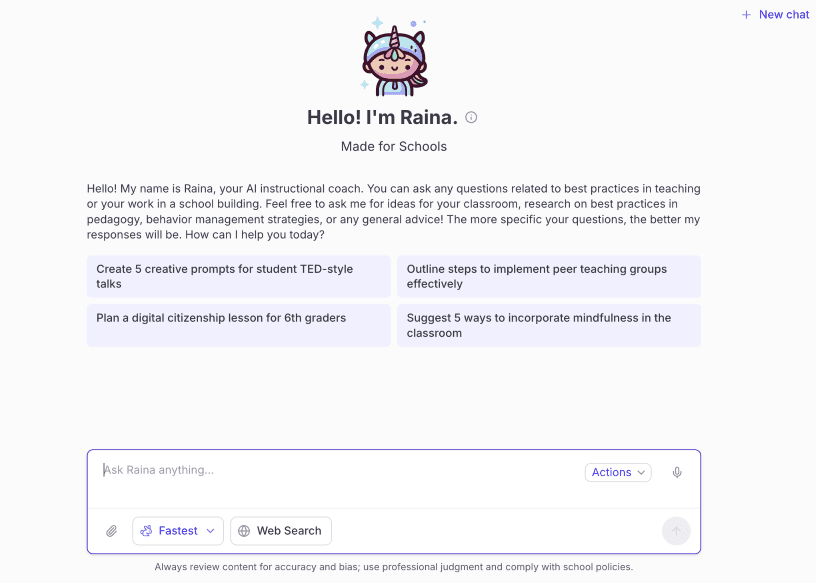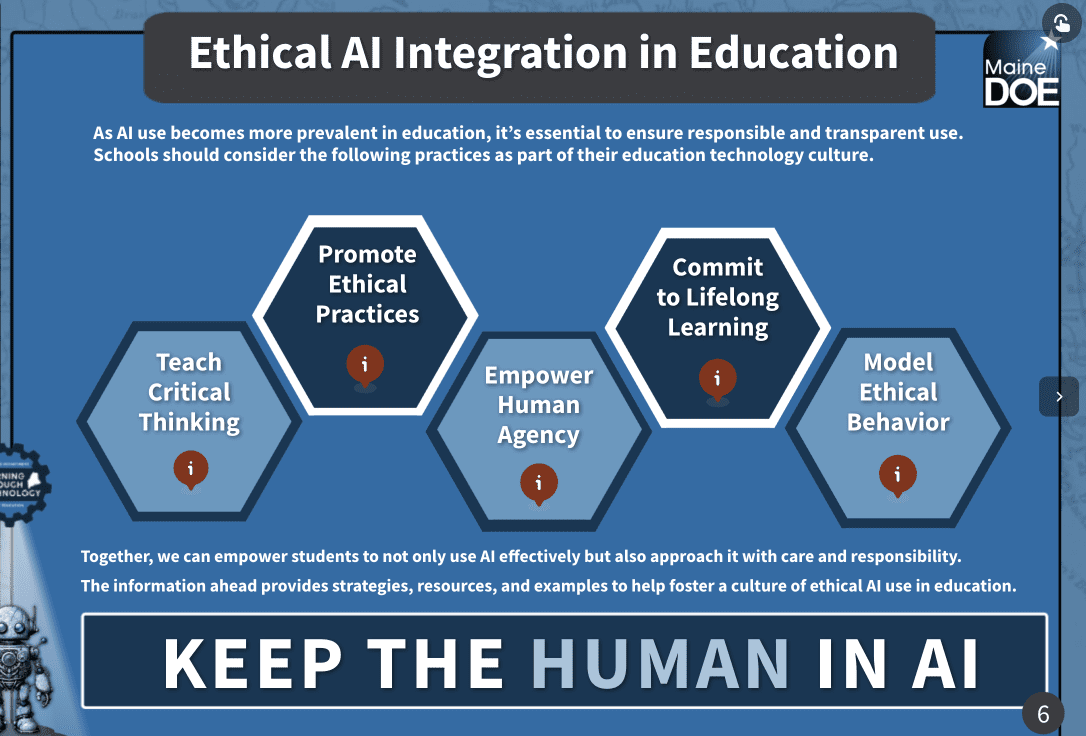[ad_1]
In Technology Director Mike Arsenault’s office at the Yarmouth School Department, papers and boxes sat on his desk — some of it swag from the tech company MagicSchool, one of several artificial intelligence programs the district is now using.
The AI platform, which was designed for educators, offers tools like a lesson planner, letter of recommendation producer, Individualized Education Plan drafter and even a classroom joke writer. The district pays about $10,000 a year for a MagicSchool enterprise package, and Arsenault said that his favorite element is the “Make it Relevant” tool, which prompts teachers to describe their class and what they’re studying and then generates activities that tie student interests to the subject.
“Because the question that students have asked forever is ‘why are we learning this,” Arsenault said, explaining that students should have clear examples of how lessons are useful outside of the classroom. “That’s something that AI is really good at.”
The district is one of many across Maine that is increasingly using AI in its classrooms. Some, like Yarmouth, have established formal AI guidelines. Others have not. MagicSchool told The Monitor that it has around 8,500 educator accounts active in Maine. This would equate to more than half of the state’s public school teachers, though anyone can sign up for a free educator account.
The state Department of Education does not yet have data on how many teachers or school districts are using AI, but said that based on the level of interest schools have for AI professional development, its use is widespread. The department is conducting a study to better understand how schools are integrating the new technology and hopes to release data next spring, according to a spokesperson.
The use of generative AI — a type of artificial intelligence that generates new text, images or other content, such as the technology used in ChatGPT — is prompting a growing debate in education. Critics see it as a tool that decreases critical thinking and helps students cheat, while advocates see it as a fixture that students must learn how to use ethically.
A majority of teachers across the country are growing familiar with AI for either personal or school use, and suspect that their students are using it widely as well, according to a 2024 study by the Center for Democracy and Technology.
As AI changes come at breakneck speed, leaders are pushing for its controlled use in schools. Roughly half of states have some form of AI guidance in place, according to the Sutherland Institute.
Maine introduced an interactive AI guidance toolkit earlier this year, which walks educators through ways they can integrate AI in the classroom from pre-Kindergarten to 12th grade and the questions to consider when doing so. Students in pre-Kindergarten through second grade could “use AI to generate art and have students collboarate [sic] to create a shared image,” according to the guidance, or high school students could “explore cybersecurity principles through ethical hacking simulations.”
The guidance encourages teachers to “keep the human in AI” by stopping to ask if its use is appropriate for the task, monitoring for accuracy and noting how AI was used.
The governor’s office launched a state AI Task Force last year to prepare Maine for the “opportunities and risks likely to result from advances in AI” in private industries, education and government. The task force’s education subgroup has met three times this year, and plans to release a report on AI use in Maine this fall.
For Yarmouth Superintendent Andrew Dolloff, it is important to help students tackle the increasingly popular technology in a safe environment. The district adopted its first set of AI guidelines last year, which emphasize that staff should be transparent and cite any use of generative AI, ensure student data privacy is protected, be cautious of bias and misinformation and understand the technology “as an evolving tool, not an infallible source.”
“AI is here to stay. It’s part of our lives. We’re all using it as adults on a daily basis. Sometimes without even knowing it or realizing that it’s AI,” Dolloff said. “So we changed our stance pretty quickly to understand that rather than trying to ban AI, we needed to find ways to effectively use it, and allow students to use it appropriately to expand their learning.”
Maine School Administrative District 75 — which serves Harpswell, Topsham, Bowdoin and Bowdoinham — adopted an AI policy earlier this year, though some school board members were hesitant to approve the policy over concerns that generative AI can help students cheat and produce misinformation, The Harpswell Anchor reported.
Some school districts, such as Regional School Unit 22, which serves Hampden, Newburgh, Winterport and Frankfort, have launched internal committees to guide AI use, while others, such as MSAD 15 in Gray and New Gloucester, are pursuing policies in the wake of controversy.
Earlier this year, a student at MSAD 15 alleged that a teacher graded a paper using AI, WGME reported. Superintendent Chanda Turner told The Maine Monitor that teachers are piloting programs that use AI to give feedback on papers, but are not using it to issue grades. The school board will be working on an AI policy for the district this school year, she said.
Nicole Davis, an AI and emerging technology specialist with the DOE who helped write the state guidelines, estimates that over 40 school districts in Maine have requested professional development for AI, and expects that interest will grow. She noted that guiding AI use can be a challenge, as the technology changes so quickly.
“We’re building the plane as we’re flying it,” Davis said.
‘I was stunned’
Julie York, a computer science teacher at South Portland High School, has long incorporated new technology into her teaching, and has found generative AI tools like ChatGPT and Google Gemini to be “incredibly useful.” She has used it to create voiceovers for presentations when she was tired, to help make rubrics and lesson plans and to build a chatbot that can answer questions during class, which she says helps her balance the amount of time she spends with each student.
“I don’t think there’s any educator who wakes up in the morning, and is like, ‘oh my god, I hope I can make a rubric today.’ I just don’t think you’re going to find any,” she said. “And there’s no teacher who isn’t tired.”
She vets all the AI resources she uses before integrating them into her work, and has discussions with her students about when using AI is appropriate. Student use is guided by the traffic light model: if an assignment is green, students can use AI under the guidance of a teacher, if it’s yellow that means limited use with teacher permission, and red means no AI. She makes these determinations depending on the type of assessment. If she wants them to be able to read code and understand what it does, for instance, then AI cannot be used. But if a student is coding a computer program, she said, then AI can be a useful tool.
AI can also help teachers accommodate diverse needs, York said, explaining that students who have trouble speaking in front of a class could use text-to-voice software to produce voiced-over videos. The district’s students speak several different languages, and she used AI to help her create an app that translates her speech into multiple languages while she’s teaching. It took her about an hour to make.
“I just sat there stunned at my computer. Just stunned,” York recalled.

Maine Education Association President Jesse Hargrove said that teachers are exploring the evolving AI landscape alongside their students, noting that AI can help create steps for science projects, or detect whether students cheated.
“I think it’s being used as a partner in the learning, but not a replacement for the thinking,” he said.
MEA’s approach to AI is guided by the National Education Association’s policy, which emphasizes putting educators at the center of education. However, Hargrove said that MEA does not have a stance on whether or not districts should adopt AI.
“We believe that AI should be enhancing the educational experience rather than replacing educators,” he said.
‘Click. Boom. Done.’
Maine’s AI guidance emphasizes that teachers should have clear expectations for AI use in the classroom. It recommends being specific about grade levels, lesson times, content and general student needs when prompting services like ChatGPT to generate lesson plans.
The state told The Monitor it does not recommend any AI tools in particular. Instead, the DOE said it encourages schools to research tools and consider data security, privacy and use.
But its guidance toolkit references a handful of specific programs. MagicSchool and Diffit are listed as tools that can help with accessibility in the classroom. Almanack, MagicSchool and Canva are noted as tools that can help boost student engagement.
The types of AI tools that educators use vary depending on their needs, Davis said, but there seem to be five tools that can assess papers, create study materials and help build curriculums that schools are turning to the most: Diffit, Brisk, Canva, MagicSchool and School AI.
“That batch of essays that’s looming? Brisk will help you grade them before the bell rings,” Brisk’s website reads. “Need a lesson plan for tomorrow? Click. Boom. Done.”
Use of these platforms is regulated by legal parameters for student data safety, such as the Family Educational Rights and Privacy Act and Maine’s Student Information Privacy Act. Technology companies must sign a data privacy agreement for the states in which they plan to operate. Maine’s data privacy agreement with MagicSchool, for instance, covers nine other states and sets guardrails for student data collection such as leaving ownership and control of data to “local education agencies.”
Some education-based AI companies also have their own parameters in place. MagicSchool, which was founded by former educator Adeel Khan, requires teachers to sign a best practices agreement, reminds them not to enter personal student information into AI prompts like an Individual Education Plan generator, and claims it erases any student information that gets entered into its system.
“We’re always iterating and trying to make things safer as we go,” Khan said, citing MagicSchool’s favorable rating for privacy on Common Sense Media, an organization that rates technology and digital media for children.

The federal government has also pushed for the use of AI in schools. In the spring, President Donald Trump signed an executive order to promote AI in education, and the federal Department of Education has since published a letter encouraging the use of grant funding to “support improved outcomes for learners through responsible integration of artificial intelligence.”
In late August, First Lady Melania Trump launched the Presidential AI Challenge: asking students to “create AI-based innovative solutions to community challenges.”
The White House is also running a pledge campaign, “Investing in AI Education,” asking technology companies to commit resources like funding, education materials, technology, professional development programs and access to technical expertise to K-12 students, teachers and families for the next four years. More than 100 entities have signed on, including MagicSchool.
In Maine, the DOE is working on broader AI professional development for teachers, with plans to launch a pilot course based on the state’s AI guidance toolkit, potentially as soon as this fall.
As Yarmouth starts the new school year, Arsenault said that AI should be integrated with the goal of preparing students for a future that will be filled with AI.
“We can do what many schools do and ignore it, or we can address it,” Arsenault said. “And if we address it with our students, we have the ability to frame the discussion on how it’s used, and have discussions with our students about how we want to see it used in our classrooms.”
[ad_2]
Source link
#Maine #schools #generative #classroom
